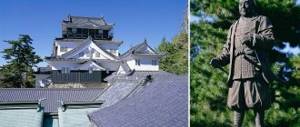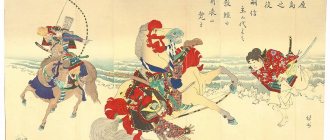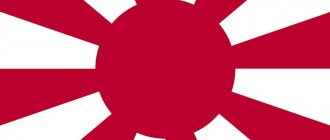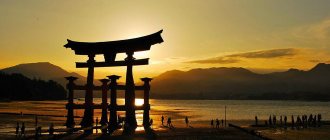Causes and spiritual basis of the Minamoto Shogunate
As you know, a society in which there is no stability craves change. In the last decades of the emperor's reign, feudal fragmentation became the main characteristic of political events in the country. The lack of centralization and unity led to severe economic consequences and frequent military riots, which only ruined the already unstable Japan. The main reasons for the change in the political system were:
- feudal fragmentation;
- lack of strong economic ties between regions;
- weakening of the emperor's power.
The first shogunate existed from 1192 to 1335. Changes in the life of the country with the increasing influence of the teachings of Zen Buddhism. This teaching gradually became widespread among military circles. It was the combination of the religious basis and military power of the samurai that led these circles to understand that they should rule the country. Samurai had a significant influence on the development of Japan.
The Shogunate was a period of significant change in Japan
Until the beginning of the 13th century, the level of development of the country remained extremely low. This stagnation would have continued further if there had not been a change in the thinking of some representatives of the military-feudal aristocracy who came to power at the end of the 12th century.
What changes occurred after the arrival of the shoguns? Let us note that life did not immediately improve, because this is simply impossible. At that time, as now, a lot depended on trade activity. With many islands and a small land area, successful trade could only be achieved with a developed fleet. The most important achievement of the shoguns was the development of port cities and the increase in the merchant fleet. For example, in the 11th century there were only 40 more or less large cities, and already in the 16th century the number of cities approached 300.
The era of the shogunate is the flowering of crafts. As you know, in medieval Europe there were craft workshops. The craftsmen who entered the workshop could work successfully. So here, too, associations of artisans gradually began to form. The same unions were formed among representatives of trade. Obviously, it is safer to do business with partners, so the effect of the formation of such alliances was obvious.
The undoubted achievement of the era of the first shogunate was the overcoming of feudal fragmentation. The main type of land ownership in the state became small samurai plots, which they received for military service.
The Rise and Fall of the Shogunate in Japan
Since ancient times, in order to maintain power, the imperial house of Japan
had to unite with some influential house.
This policy led to the fact that by 1156 the power of the emperor became extremely limited, and the Taira
and
Minamoto
.
In the end, the Minamoto
and in order to legitimize it, Minamoto no Yoshinaka demanded that the emperor appoint him shogun, previously this was the title
of a commander
leading campaigns against the northern barbarians.
Previously, the title of shogun allowed the Japanese army to be summoned against the Ezo, who lived in the northeast of the country, since they were strong. Such campaigns required all possible resources, including human resources. By the 12th century, the Ezo
had weakened and pacified, and began to join the troops of the Japanese rulers, but the title remained, which
Minamoto no Yoshinaka
.
The new shogun not only monopolized the right to raise troops, but also significantly expanded his powers, concentrating the military-civil power of Japan
, the emperor remained the embodiment of the gods on earth and without real power.
In the period from the XII to the IXX centuries. many shoguns
and military leaders, stronger, weaker, dividing and uniting the country. However, this could not last forever.
After the discovery of Japan
, European countries fighting for colonies in Asia began to look for access to the markets
of the Land of the Rising Sun
, which was extremely difficult due to the policy of self-isolation that was established by the Takugawa Shogunate
after
the Christian uprising in Shimabara in 1637.
Japan's policy of isolation was interrupted by American Commodore Matthew Perry
.
His expeditions of 1853-1854 were aimed at conveying to the emperor proposals for friendship and trade, it is noteworthy that the commodore was allowed to use force to conclude a treaty. Thus, by threatening war, Perry interrupted Japan's self-isolation and achieved the conclusion of the Treaty of Kanagawa
, which opened two ports for the Americans for the purpose of trade and settlement.
Next, the Shimoda Treaty was concluded with the Russian Empire
, regulating trade relations and controversial territorial issues, and the last point was the unequal Ansei treaties, which prohibited Japan from independently setting duties and prosecuting foreigners.
Shogunate
showed itself to be a form of government that did not know how to adapt to changing conditions, reacting to them too late, it became obsolete and caused increasing anti-government sentiment.
Among the Japanese aristocracy, the question arose of restoring imperial power, a course towards modernizing the state along Western lines and the formation of the Japanese Empire
to a number of great countries. Such changes could not occur in a country led by shoguns who had already become weak and unauthoritative.
Tokugawa Yoshinobu -
the last shogun wanted to create a new government, which would include the capital's aristocrats and representatives of the emperor, on the ruins of the shogunate.
The shogun himself would become prime minister, retaining power after the reforms. Yoshinobu
resigned on November 9, 1867, and returned power to the emperor, but his hopes for the position of prime minister, which would be hereditary, were not realized.
The pro-imperial party suppressed the pro-shogun party, the positions of shogun and regent under the emperor were abolished, the emperor
received full power over the country. The 500-year reign of the samurai fell under the pressure of time.
Reasons for the revival of the shogunate in the 17th century
The Tokugawa shogunate is the reaction of traditional Japanese society to the events that took place in the state in the mid-second half of the 16th century. The second coming of the samurai to power had its own logical reasons:
- continuation of feudal fragmentation;
- slowdown in the country's economic development;
- the appearance of European ships and the gradual development of trade with Portugal and other European countries.
The most important and painful topic for the samurai was the appearance of foreign elements (Europeans) who came into contact with a traditional society that had been established for centuries, which had previously maintained close contacts with culturally similar China and Korea. Historians believe that the establishment of contacts with Europe became a logical impetus for intensifying the struggle for the creation of a centralized strong state.
Japan/Edo Period (Tokugawa Shogunate) (1603–1867)
After Hideyoshi's death in 1598, Tokutawa Ieyasu took power into his own hands, winning the decisive Battle of Sekigahara (1600); in 1603, he accepted the title of shogun from the emperor and founded a new military headquarters in the city of Edo (now Tokyo).
After a period of feudal fragmentation and civil wars, Japan was reunited into a single state.
Tokugawa Ieyasu began, and his descendants continued, a number of important political and socio-economic changes in the country.
A permanent administrative system of the shogunate was created. The emperor and his court, as before, were completely removed from power. Striving for total control of the country, Tokutawa introduced a strict division of society into 4 classes (samurai, peasants, artisans and merchants), the highest of which was recognized as the class of noble samurai.
At the same time, all spheres of life were subjected to strict regulation, down to the smallest details of everyday life.
One of the important tasks of the Tokugawa shogunate was the expulsion of Europeans and the prohibition of Christianity, which resulted in the complete “closure” of the country and the cessation of contacts with the outside world.
The only exceptions were made for China and Holland, with which limited contacts continued throughout the Edo period.
This period was characterized by rapid urban growth, the development of urban culture and economy, and a sharp increase in population.
However, already from the middle of the 17th century, crisis phenomena began to be observed, and the economic situation worsened. The situation was aggravated by famine, peasant riots and the impoverishment of the nobility.
Attempts at reform did not bring results.
Since the beginning of the 19th century, pressure from foreign powers has intensified. Attempts to tighten the “closed” regime failed, and in 1853, under the threat of American force, the Japanese government agreed to open several ports.
Japan in the 17th-19th centuries
The era of the shogunate is a manifestation of absolutism in Japan. Of course, we should not forget about the existence of the imperial dynasty, but the power of these persons was more spiritual than secular. The shogunate regime created a “closed” state. European ships were prohibited from entering Japanese ports. If suddenly such a ship came into port, its crew was subject to execution. This isolation lasted 250 years, until the middle of the 19th century.
If we talk briefly about the Tokugawa shogunate, then this is a period of total pressure on the peasantry. Formally, there was no corvee in the state, but many peasant lands still belonged to large feudal lords. Various taxes and levies on peasants, which were officially introduced, accounted for approximately 60% of the harvest.
Relations between the shogunate and daimyo
Samurai rulers who had lands with incomes above 10 thousand koku were called daimyo and were in a suzerain-vassal relationship with the shogun. Among the daimyo, of whom there were 300 people, a hierarchy was established according to the degree of closeness to the shogun family:
- Tokugawa relatives;
- ancient vassals;
- new vassals.
For all landowners, the government published the “Military Houses Law”, according to which daimyos without permission had no right to build castles on their lands and enter into political marriages. Daimyos who did not comply with these prohibitions were deprived of their possessions or transferred to other, less profitable regions of the country. To control the samurai feudal lords, the shogunate created a system of assignments, when the daimyo had to arrive in Edo every year and live there for a year. In addition, by order of the government, landowners had to perform construction and military duties in favor of the center. Despite this burden, the daimyo had freedom to manage their estates. These possessions were called principalities.
Finished works on a similar topic
Coursework The Third Shogunate and the policy of “isolation” in Japan 480 ₽ Essay The Third Shogunate and the policy of “isolation” in Japan 240 ₽ Test The Third Shogunate and the policy of “isolation” in Japan 210 ₽
Receive completed work or specialist advice on your educational project Find out the cost
In addition to control over the regions, the shogunate limited the rights of the imperial court, turning it into a system dependent on the samurai government. According to the “Law on the Imperial Court and Kuge,” the shogunate was obliged to financially support the emperor, but liquidated his land holdings.
Estate system
The shogunate is a government system that was supposed to preserve the old traditional system. A class system was introduced in the state. The population was divided into 4 groups: peasants, artisans, samurai, merchants. The main goal of such a division: the preservation of the social structure existing at that time, when the power of the shogun and the privileged position of the samurai were to be perceived undeniably.
The merchants were considered the lowest class, but in reality they were more successful than the peasantry and artisans. Cities continued to develop. At this time, Japan already had more than 300 cities and towns. The basis for the development of cities was active trade between the islands and with nearby states (China, Korea), as well as a large number of craft associations.
Domestic and foreign policy of the shogunate
Tokugawa Ieyasu encouraged trade. From 1604, by his order, the courts of Western daimyo and merchants of the cities of Nagasaki and Sakai, who conducted foreign trade, were required to obtain licenses - letters of approval with red seals, so that they would not be confused with pirate ships. Licensed ships traded extensively in Macau, Taiwan and various regions of Southeast Asia.
Many Japanese who went abroad settled there, forming Japanese trading colonies. At the beginning of the 17th century, the number of overseas Japanese was 10,000 people. The most famous was Yamada Nagamasa, who received a high official title from the Siamese king.
In the beginning, the shogunate promoted trade relations with Western countries and was kind to Christianity. Thanks to this, the government treasury was replenished, and the number of Japanese Christians grew. However, the confrontation between European states in the Japanese market forced the shogunate to reconsider its foreign policy course. In 1617, the shogun issued a ban on the spread and practice of Christianity, and the arrival of Spanish ships in Japan. Restrictions were gradually placed on Japanese merchant boats leaving the country. In 1635, the government prohibited Japanese from leaving Japan at all or returning if they were abroad.











